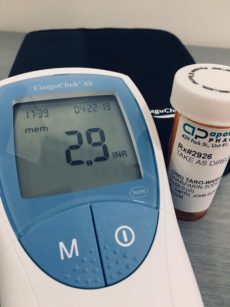What is an INR test?
INR stands for International Normalized Ratio. It’s a blood test that measures the time it takes for your blood to clot.
Who needs the test done?
This test is required if you are taking warfarin (or Coumadin) which helps your health care team monitor the effect of the drug. It is not possible feel changes in your blood, as a result regular blood monitoring is done so that your dose is always correct.
What is a low INR?
This tells us that your blood is too “thick” and your dose of warfarin may not be effective. This places you at higher risk of developing a clot and your warfarin dose may need to be increased.
What about a high INR?
When your INR is too high, your blood is considered too “thin” meaning that you might be at a higher risk of developing side-effects from warfarin, namely bruising or bleeding. In these cases, the warfarin dose may need to be lowered.
What are the different ways of testing INR?
1) Lab
The traditional method is going to a lab where a technician would draw a vial of blood from a vein in your arm. LifeLabs and Dynacare are the two most common companies and they have multiple locations across Ontario. For those that are unable to physically go to a lab, a technician may be able to do a “house call” where they would come to your home (or retirement home) to collect blood for a fee (which is around $25-30 per visit).
2) Point of Care Device
More recently, point of care devices have been made available that provides instant results using a small drop of blood from a fingerpoke (similar to how diabetic patients test their blood sugars). These devices are used in many pharmacies and medical clinics. A few of the main benefits include:
- Portable and convenient
- Faster results
- Less blood needed to complete the test (drop of blood from the finger vs. blood from a vein)
- Less pain providing a blood sample
- Research shows that these point of care devices are as accurate and precise as the lab
Some patients even decide to purchase their own to test at home or while away (such as snowbirds living away who do not want to go to a foreign lab).
The table below compares the INR tested at a lab versus using a point of care device:

INR testing at Apothecare Pharmacy
At Apothecare Pharmacy, we offer free INR testing to our patients on warfarin (Coumadin). We’re able to test your INR on the spot, provide instant results and tell you how to adjust your warfarin dose if necessary. We work closely with your doctor to ensure they are aware about your INR results and any dosing changes that we make.



0 Comments